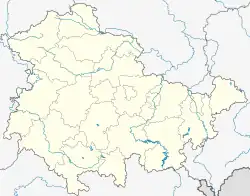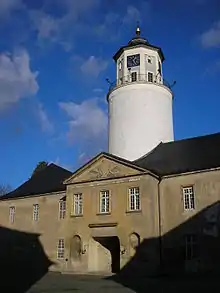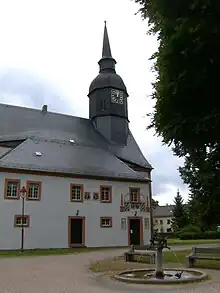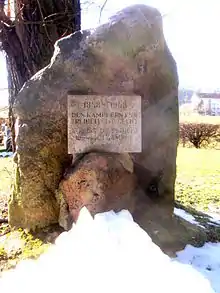Crossen an der Elster | |
|---|---|
Location of Crossen an der Elster within Saale-Holzland-Kreis district  | |
 Crossen an der Elster  Crossen an der Elster | |
| Coordinates: 50°58′35″N 11°58′40″E / 50.97639°N 11.97778°E | |
| Country | Germany |
| State | Thuringia |
| District | Saale-Holzland-Kreis |
| Municipal assoc. | Heideland-Elstertal-Schkölen |
| Subdivisions | 3 |
| Government | |
| • Mayor (2020–26) | Uwe Berndt[1] (Left) |
| Area | |
| • Total | 10.74 km2 (4.15 sq mi) |
| Elevation | 176 m (577 ft) |
| Population (2022-12-31)[2] | |
| • Total | 1,607 |
| • Density | 150/km2 (390/sq mi) |
| Time zone | UTC+01:00 (CET) |
| • Summer (DST) | UTC+02:00 (CEST) |
| Postal codes | 07613 |
| Dialling codes | 036693 |
| Vehicle registration | SHK, EIS, SRO |
| Website | www.crossen.de |
Crossen an der Elster is a village and municipality in the district Saale-Holzland, in Thuringia, Germany. The White_Elster is the name of the small river which flows through the municipality, so 'Crossen on the Elster' would be the English equivalent.
It is home to the Crossen Palace, a Baroque building with an Italian-style decorated ballroom.

History
The first documented mention of Crossen was 31st March 995.[3]
In 1937 the name of the town was changed to Krossen/Elster. From 1st January 1991 it was officially renamed to Crossen an der Elster.
Culture and Sights
The main attraction is the baroque castle; however it is not open to the public.
In addition, there is the revamped church Michaelis's Church, which was first documented in 1320.
Monuments
There is a monument in the graveyard by an old linden tree in memory of the revolutionaries of 1848. It was erected in the year 1948.
Beside the school there is a memorial for the victims of fascism. It commemorates the resistance fighters of the area, including Communist Party member Willy Graumüller, who was murdered in Bergen-Belsen concentration camp. The Teisker-Siedlung street name is also named for him.[4]
In November 2016 a 'stumbling block' memorial was laid for Willy Graumüller.
Historical Population
|
|
|
|
|
Source: Central Statistics Office of Thuringia
Mayor



The honorary mayor Uwe Berndt (The Left) was elected in June 2014.[5]
References
- ↑ Gewählte Bürgermeister - aktuelle Landesübersicht, Freistaat Thüringen, accessed 14 July 2021.
- ↑ "Bevölkerung der Gemeinden, erfüllenden Gemeinden und Verwaltungsgemeinschaften in Thüringen Gebietsstand: 31.12.2022" (in German). Thüringer Landesamt für Statistik. June 2023.
- ↑ Wolfgang Kahl: Ersterwähnung Thüringer Städte und Dörfer. Ein Handbuch. 5., verbesserte und wesentlich erweiterte Auflage. Rockstuhl, Bad Langensalza 2010, ISBN 978-3-86777-202-0, S. 50.
- ↑ Thüringer Verband der Verfolgten des Naziregimes – Bund der Antifaschisten und Studienkreis deutscher Widerstand 1933–1945 (Hrsg.): Heimatgeschichtlicher Wegweiser zu Stätten des Widerstandes und der Verfolgung 1933–1945. Band 8: Thüringen. VAS – Verlag für Akademische Schriften, Frankfurt am Main 2003, ISBN 3-88864-343-0, S. 206.
- ↑ "Kommunalwahlen in Thüringen 2014. Bürgermeisterwahlen 2014 in Thüringen. Vorläufige Ergebnisse" (in German). Der Landeswahlleiter. Retrieved 2014-06-13.